 Toshihiro Takada
Toshihiro Takada
Ritsumeikan University
Environmental Systems Engineering
Status: B4 Expected Graduation: March 2017
Research Host Lab: Ajayan Lab, Materials Science & Nanoengineering, Rice University
![]() Research Project Poster: “Synthesis and Characterization of Metal-Organic Frameworks for Multifunctional Applications”
Research Project Poster: “Synthesis and Characterization of Metal-Organic Frameworks for Multifunctional Applications”
Why Nakatani RIES?
I am majoring in Environmental Systems Engineering in the faculty of Science and Engineering, and especially studying water environment at my university. I started my thesis research last November as a member of “Environmental Sanitary Engineering” laboratory whose main theme is to disinfect microbes and decompose organic matters by using ultraviolet (UV) radiation. The first step of my research is to consider a current situation of refractory organics in the water and next to progress to materializing future water supply, which is “decomposing organic matters in sewage by using vacuum UV (VUV, a wavelength below 200nm)”. I applied to this program to explore my original study topic and enhance international experiences. I strongly believe that this program will make my undergraduate study more scientific, futuristic and bring to the national level.
Rice University, one of the most famous research universities in the U.S., recognizes a great accomplishment and been conducting frontier researches in science and technology fields. Because my interest is in the water environment and waste water treatment, I am very eager to seeing the Center for Biological Environmental Nanotechnology (CBEN) and Nanotechnology Enabled Water Treatment (NEWT) at Rice University. I hope to learn how they treat waste water in terms of nanoscale chemistry, and keep water sustainability there. Through this program, I would also like to seek for potential effectiveness of the water treatment system, and come up with new ideas how I should perform my research after the program. This Research and International Experiences for Students (RIES) program will absolutely develop technical skills of my research and cultivate international understanding between the U.S. and Japan; furthermore, the mutual understanding between the two technological countries, which have many Nobel laureates in science fields, should take advantages of each strength in science. I believe that will trigger other nations and people who are interested in engineering to follow.
Goals for the Summer
- To consider my research topic, and seek for how my scientific skills should be used and useful for future science.
- To realize how Rice University treats water and waste water and what is different from that in Japan.
- To find out what Japan lacks in current Science and Technology fields compared to the U.S., and come up with how we improve it for the further steps.
- To make myself understood as much as in English during this program even though it is a specific topic in Science.
- To enhance understanding of other science and international fields by having discussion with other Japanese and U.S. fellows.
Excerpts from Toshihiro’s Weekly Reports
- Week 01: Arrival in the U.S.
- Week 02: First Week in My Research Lab at Rice
- Week 03: Interview with a U.S. Researcher
- Week 04: Reflections on English Language & Life in the U.S.
- Week 05: Research in the U.S. vs. Research in Japan
- Week 06: Final Week at Rice & Research Poster Presentation
- Week 07: Visit to Washington, DC & New York City
- Final Report: Reflections on the Nakatani RIES Fellowship
Week 01: Arrival in the U.S.
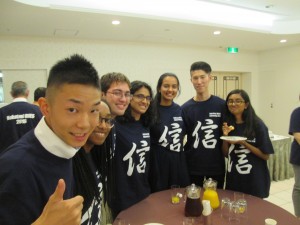
The Nakatani RIES Program for Japanese students started with other Nakatani U.S. fellows in Azabu-Juban, Tokyo. Although we were together for only a few days, I was able to learn a lot from my discussion with them. I found each of the U.S. students had a clear-cut goal and a strong will to do their research. While I was in Tokyo, I also had a great opportunity to meet the president of the Nakatani Foundation and some board members. They gave us guidance for our health & safety during our stay in the U.S. and held a special seminar with a professor and a student who had previously done research at Rice University.
When I arrived at the airport in Houston, I felt such humid and hot weather that I got worried about becoming dehydrated, so I kept in mind to drink enough water throughout my stay. The whether changes a lot here with a sudden heavy rain because of the geographical features in Texas, so I also need to carry an umbrella every day even though it is sunny during the daytime. Our visit to the National Aeronautics and Space Administration (NASA) helped me understand that Houston was an advanced modern city in the U.S., even if the entire Texas was not. However, on our drive to NASA I saw many households, shopping stores, and medical centers, which were different from what I expected.
During my first week in Houston, I toured the Rice University campus and participated in some seminars. One of the most helpful seminars was the talk on “Graduate Study & Academic Careers in the U.S.” by Professor Kono, who is a research director and supervisor for the Nakatani Japanese students. What I learned from his lecture was that even graduate students are given salary in the U.S. and they could spend a lot of time doing their own research and focusing on it. I was impressed by the U.S. system because few Japanese students can be devoted to their own research because they often must have part-time jobs to earn money. I feel the U.S. has a good educational environment for students and researchers to be dedicated their project and research.
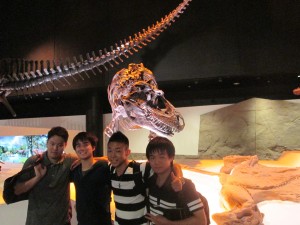
Also this weekend, some of Nakatani students and I visited the Houston Museum of Natural Science, where I was able to look around historical and educational science. Though I have been to some science museums in Japan, the Houston museum was quite interesting, considering its large volume of contents, originality, and simple exhibitions for children to understand. I also had a hamburger at lunch, which was my first time to eat a U.S. hamburger in Houston. It reminded me of how most of food in the U.S. is much bigger than that in Japan and a good value for money. Despite the hot and humid day, I enjoyed a lot this first weekend in Houston.
What did you do to prepare for your research internship at Rice University while you were in Japan?
Before coming to the U.S., I tried to deepen my current research on water treatment processes because I wanted to have discussions about environmental concerns with many people while I was in the U.S. To expand my knowledge, I looked through some of the regulations of Environmental Protection Agency (EPA) and read a document of “Water Treatment Process Control” by the Technical Learning College. I also contacted my host professor and mentors before I came to Rice University. They sent me some papers to read, which would be useful for preparing for my research at Rice. I will be doing materials science research in this area. I read all the papers and tried to understand how to make and use composite materials. Because of my lack of my expertise in materials science, I found some key words from websites and started to learn them from a fundamental level.
I think I was not able to do enough preparation for this program due to my exams and interim report being due at my college at the same time. I should have looked into my research topic more and found out other reports involved in materials science. For future participants, I recommend, even though you have exams and final reports at your college, you should focus on the research that you are going to conduct in this program as much as you can. Another piece of advice is, if you study at Rice, you should learn and have knowledge about nano-science and nano-technology because many students at Rice are interested in them and a lot of their research is associated with a kind of nano-scale technology.
Question of the Week
One question I am curious about the life in the U.S. is how to throw away garbage and waste. Actually the hotel where I am staying has only one (single type) trashcan. When I have breakfast there, all of the garbage is thrown into the single garbage can without separation between combustibles and non-combustibles. I learned here in Texas, there was a single-stream recycling system, which you put all your recyclable waste, such as glass, paper, and some plastics, into one blue bin and they sort it at a recycling facility. However, I have hardly seen multiple separate systems in the entire U.S. like in Japan.
Why do most places have one garbage can? Is it enough for efficient recycling? In addition, I throw away wasted oil into a kitchen sink directly when I cook something with oil. Because a lot of water is needed to dilute oil in the water, I am very worried about the burden by the treatment. Are there any containers or places to treat the wasted oil or how is it treated after use?
- Excellent question! U.S. students are often confused about where to throw away trash and recycling in Japan because there are to0 many choices of separate bins and Japanese students are often confused because there is only one trash bin in many place. Unfortunately, recycling is optional in the U.S., and not all businesses provide recycling bins. University campuses often lead the way in terms of rates of recycling and at Rice University there is a special Sustainability program and Campus Greening initiative including a requirement that all new buildings on campus be LEED certified.
- In addition to single stream recycling, the City of Houston also has special drop-off sites for other recyclables such as batteries, paint, electronics, etc. For example, click here to learn about the drop off locations for cooking oil. Without a car though, it is a bit inconvenient to collect and drop off used cooking oil.
- It is not a good idea to throw used cooking oil down the kitchen sink as it could coat/clog the pipes. Rather, let your used cooking oil cool and then pour it into an empty can or carton that you can then throw away in the trash can.
- Most U.S. cities will have websites with information on trash/recycling options in the area so when you move to a new city in the U.S. (or a new university) it’s important to look up what recycling services are available in your local area. Click here to see a recycling guide for Houston.
Week 02: First Week in My Research Lab at Rice
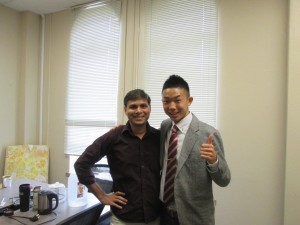
My first day in the lab was very memorable. I was very nervous that morning and I could not eat much for breakfast. However, when I met and talked to my mentor and professor in the Mechanical Engineering Building (MEB), I felt relieved and my tension eased by their smiles. In fact, there were so many members of the Ajayan Group that I did not see all the members my first day. Because there is also a lot of shifting of members during each semester and year, some members do not seem to know each other very well. I have never seen such a large laboratory with a large number of Postdoctoral and Doctoral students and I am excited to work here and do experiments with them. My mentor is Dr. Ashok Kumar Meiyazhagan from Tamil Nadu, India. His current research is the synthesis of lithium metal-doped organic molecules for energy storage applications and synthesis of high performance 3D nano-composite materials for multifunctional applications. Although I did not meet Professor Ajayan at the first lab visit, I was able to meet him the next day.
Since I started my research at Rice, I had found some unique and interesting points. First is the layout of the office, where the desks are placed in all four directions and a table is placed at the center of the room. People are likely to communicate with each other and have heated debate. On the other hand, most desks in an office in Japan are placed in a row and students have to pass between the desks to talk to others, which make it hard to have enough discussion and debate. The other point is language people usually speak. Naturally all people speak English when they work on the campus and even people from the same country who can speak their mother language usually communicate in English in the lab. Very inspired by their motivation and enthusiasm, I also decided to try to speak English when I speak to Japanese people during this program.
Honestly, it is a little hard for me to communicate with others in the lab only in English because some words need technical knowledge and the others are used in a complicated situation. I regret that I have not studied enough before coming to Rice. However, I feel that speaking English in the lab is very fascinating and enjoyable because I can learn new scientific words and ideas through my discussions. The more I speak English, the more excited I get. Also this week, I was able to learn the more about how to prepare for and present at a poster presentation through a seminar given by Dr. Beata Krupa of the Rice Center for Engineering Leadership. Since I have never made a poster before in Japan, the lecture helped me a lot to improve my presentation skills.
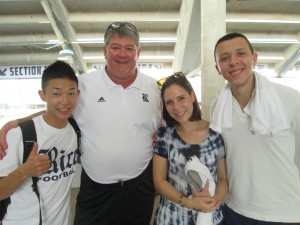
This weekend, I joined many events, one of which was the Rice International Football Clinic. Rice Football players lectured international students and I tried to play football. I got to experience various kinds of U.S. culture, which I had never understood in Japan.
Question of the Week
Although one week has passed since I came to the U.S., I have not seen students except for Rice University. What do most students do or spend on weekends? It probably depends on degrees or individuals, but I am wondering their activities.
- Undergraduate classes at Rice University do not begin until August 22 (the Monday of your 3rd week) so this may be why you do not see many students on campus or in Rice Village at night or on the weekends. Once all of the undergraduates are back on campus there will be more students around probably. While there are graduate students on campus all year round they usually live off campus and many have cars so they go out all over in Houston rather than in one specific area. We encourage you to be curious and ask your lab mates and the Rice undergraduate students you meet what they do for fun in the evenings or on the weekends. As you noted, this will vary a great deal by person. You could also ask some of the Rice University Nakatani RIES U.S. Fellows if you can come visit them in their residential college (dormitory) in the evening or on the weekend so you can learn more about what student life is like there too.
Research Project Update
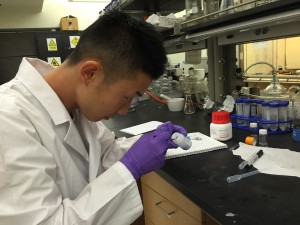
My research project is “Synthesis of highly porous 3D composite materials for environmental applications.” Since I have been studying environmental systems engineering in Japan, making composite materials for environment in this project must be useful and important to produce eco-friendly products in the future. Talking with Professor Vajtai and Dr. Ashok on the first day, my project was divided into three steps and I will conduct it each step at every week. Basically, the first step of my research is to make the 3D composites materials (in 1 & 2 weeks) to do experiments against chemical objects. Then the next one is to analyze those of the materials with using oil, chemical substances, and waste water (in 3 & 4 weeks). Putting together these results into my report to make the poster (in the final week), I will discuss what the good composites are, and discover a new approach to environmental applications. This week, I was trying to make composite materials with my mentor. He taught me how to make them and to handle the equipment, which I need for my research.
In order to do experiments at Ajayan’s laboratory, I needed to complete the General Laboratory Safety Training by the Rice Office of Environmental Health & Safety and the general lab safety training by a member of Ajayan’s group. Through these trainings, I learned what I should and should not do, and how to evacuate in case of emergency, which would be essential to do research. Unfortunately, due to safety regulations I could not do much research during this week. However, I initiated the experiment, where I employed Graphite Oxide so called GO, and mixed them with Triethylamine (N(CH2CH3)3) and Copper(Ⅱ) nitrate hydrate (Cu(NO3)2) in water medium to form gel material. Additional details about the experiment will follow in next week update.
I was pleased with what I did in the first week because I was able to combine some chemical substances and handle some equipment in which I had never used in Japan. One thing I was interested in during the experiments was the method to stir up materials. While I use a stirrer to stir up materials in my laboratory in Japan, here we used sonicator to stir up. That is because the process of making composite materials is quite different from that of my doing research about decomposing organic matters by the UV radiation. The final day of this week, I also helped in fixing the freeze dryer, which was needed for making vacuum and synthesizing composite materials.
Week 03: Interview with a U.S. Researcher
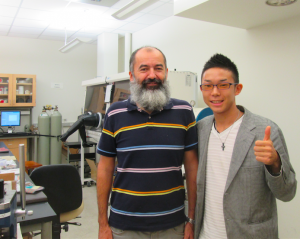
Dr. Robert Vajtai is a Professor. Although he studied chemistry in his high school, he was interested in physics and obtained his M.S. degree in physics and his Ph.D. degree in solid-state physics, which was about material forms and structures of oxide using laser, from the University of Szeged, Hungary. Surprisingly, he got his PhD. degrees twice (one of them is a Doctoral). He joined Prof. Ajayan’s group in July 2000, and he has been at Rice University as a professor for eight years through 2008 to 2016. He said the research style in Hungary was different from that in the U.S. He feels that U.S. research is harder than that in his country because students have to carry out their research with their assignments well done. Though you can get money if you are a scientist in Europe, not in the U.S.
Compared to his master and PhD. courses, Ajayan’s laboratory has a lot of international students, most of who are from India and China. Rice University consists of 20% international students and 80% U.S. students, while he had only one international student when he studied in Hungary. Most of the international students from other countries came to Hungary to study medicine and few of them studied science and technology. He feels the friendly atmosphere with international students in Ajayan’s laboratory is suitable for research environment. He sometimes has hard time to handle the instruments in the laboratory because they are different from those of Hungary. He has been to many countries in Europe as well as Sweden. He feels that the internationalization brought him new collaborations and development in his research. International research is superior to domestic research because new ideas, techniques, and criticism are more likely to be introduced. If research is conducted by only domestic students, it may hardly be internationally accepted.
Since he has been to Japan a few times, he already knows about the research of Japan. He thinks that Japan has traditional fashion and culture, and they bring about good effects on research. The behavior of Japanese students is respectful and polite. Professors organize to promote research for their students, which is the style other countries cannot imitate. As a result of this unique style, Japanese researchers lately won the Novel prize in physics and chemistry. He also suggests possible improvement in Japanese research, which is as for publication of results. Even though there are many excellent researches in Japan, some of their works have not been internationally well known because it is published only in Japanese. Then the readers of the research are limited. If we have more opportunities to publish in English, we can reach the higher technological achievement with more approval as well as the U.S.

Joined one of activities of the Outreach Day this weekend, in which students support refugee people, and helped packaging food at Food Bank. ~ Toshihiro Takada
Reflections on Interview:
Through the interview, I learned a lot from him I have never thought before I came to Rice. I thought that the U.S. was one of the best countries where people do research and attain to their goals, but it is not always best when considering many surroundings. One surprising thing was that researchers in the U.S. are still having trouble in getting enough funding to pursue their research because I thought the research and development (R&D) and financial systems have already developed. Funding and financial support for scientific projects are essential for researchers to keep up their work and get good results. I was also surprised at his view that Japanese professors organize their laboratory well and they have more specific knowledge than the U.S. professors. For example, my professor in Japan, an expert of ultraviolet (UV), has the highest technical skills with experiences of research about UV for 40 years; nobody else in the world has the specific knowledge and skills as he does. Besides, while many students in the U.S. tend to change majors when they go to graduate school and take PhD. course, basically Japanese students usually choose the same theme. For this reason, most Japanese professors let students study the same research topic as their bachelor’s.
I think that research in the U.S. and Japan each has advantages and disadvantages. He also told me that the research in the U.S. is great but it is more comfortable to live in Europe. If I go to graduate school and take PhD. course abroad, I have to think about these points carefully; which country is the best and brings the deepest satisfaction to me. However, in my point of view, compared to Japan, it is easier for people to be engaged in their research and have more opportunities to publish their achievement in the U.S. Now I think because a number of researchers in Japan are high quality with great achievement, the researchers should put more emphasis on the publication in English so that many people around the world can focus on and get interested in them. I also think students who are studying science should know how important it is for them to publish their research in English for their future careers. They need to learn more scientific English, in particular how to write a thesis with accuracy in English.
Question of the Week
Is there any difference in the process of becoming a professor between the U.S. and Japan? Through the interview, there might be difference between Japan and other countries. In order to become a professor in Japan, we have to get PhD. degree at first and next to become a research associate, an assistant professor, and finally a professor. If the process goes well, we can take a post of a professor as young as 40 years old in national universities. How about the U.S. promotion system of the professors?
- Prof. Kono gave an excellent talk on this topic during your first couple of days at Rice. You may want to review his slides again or email him to ask him additional questions. You can also ask Google-sensei “How to become a professor in the U.S.?” and you will find many excellent articles and resources. This does vary a bit by field of research/study though so the best thing to do is ask the U.S. professors you know what advice they would give you if you wanted to become a professor in the U.S.
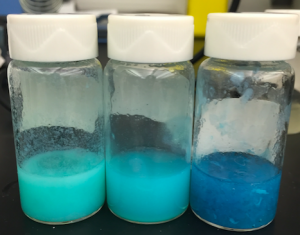
Research Project Update
This week, I tried to make some metal organic frameworks (MOFs) in the process of making the 3D composite materials, following by each step of my research project with my mentor. We made three types of MOFs, used combination of Trimesic acid (C9H6O6) and Mellitic acid (C12H6O12) with Triethylamine (TEA), Cupric sulfate (CuSO4), and Copper (Ⅱ) nitrate (Cu(NO3)2). One interesting phenomenon was that we could see various colors such as light blue or dark green, depending on weight and combination of each chemical substance, which means we can recognize the state of chemical reaction directly during the experiments. I also helped my mentor’s project this week, which was the first trial to make a highly porous sponge using GOs. Our plan in this week was to make highly porous 3D composite materials by synthesizing these MOFs and GOs, but that will be carried over next Monday because the GOs were not a good condition to be synthesized. I decided to use these materials for oil and dye absorption experiments for my poster presentation on September 16. I also hope to test the materials to sewage treatment, especially water filtration, if I have some time before the presentation.
Through one of his project, I could observe highly porous gels. In order to make them, I mixed Polymer, TEA, and CuSO4, changing the dose of each chemical. We were able to make the new type gel, in the process of making five different types of solutions in which they had different color, stickiness, and the number of particles. Since I have been doing research with my mentor for long time this week, and I was also able to learn an important lesson from him. He told me that doing research means not only doing experiments but also other things such as reading journals and gaining knowledge, which indicates doing research takes a very long time. Although doing experiments is just part of research, I seemed to be involved in doing experiments too much in Japan. However such the research has little mean and likely to be waste of time. I need to think about my research project carefully before I start the experiments next time. This weekend, I also visited laboratory and kept sonicating the GOs until they become homogeneous.
Week 04: Reflections on English Language & Life in the U.S.
Time flies by so fast! Three weeks have already passed since I came to Houston and it is now September. As I mentioned in the my week 2 report, using English is very exciting and fascinating to me. I also have been trying to speak English to everyone, even with the Japanese people I meet in Houston. Basically I speak only English in my lab, so this is an ideal my environment for me. Through using English to discuss research with my mentor, I have been able to learn many new words, from scientific and technical words to just simple ones for day-to-day conversation that I could never learn in Japan. Although I have talked to 100 or more new people since I came to the U.S., each conversation has been a very good opportunity for me to use English and learn the new phrases and also to gain new knowledge and information about Houston. However, I feel I still have problems when I say something in a long sentence. My English knowledge lacks enough vocabulary and grammatical correctness, so it is hard for me to make a long sentence, which sometimes causes misunderstanding when I want to explain a phenomenon or scientific word. I want to improve this weak point by reading many books and memorizing both scientific and ordinary words as much as possible through this program.
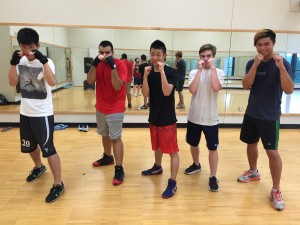
Joined the Rice boxing club and tried to speak to a large group of people in English. ~ Toshihiro Takada
One of the challenging experiences for me to communicate in English is speaking to a large group of people. Because I often only talk to one or two people when I am speaking in English, I have had few experiences to talking to a large group in order to make my ideas understood. Fortunately this week, I had an opportunity to join some club activities at Rice, which were the Rice Environmental Club and the Rice Boxing Club. Although there were a lot of members present in the meeting of the Rice Environmental Club, I was able to speak up about my ideas to other members. However, I tried to speak up about something again in the boxing club, but I failed to make myself understood. I should have talked more aggressively and told myself that I should not be afraid of making mistakes. I have been learning English for a long time, but still sometimes have hard time to tell others what I really want to inform. Actually I have some tips about communication when I in speak English; I always should be positive and confident, and keep speaking meaningful things as far as I can. Furthermore, when talking to someone from different countries, I also try to make up my mind to be friendly and energetic as much as possible. That is because people in the U.S. usually prefer an extrovert while Japanese people are basically more introverted as well as polite and prefer a calm and diligent character. For this I always keep in my mind to have courage and confidence so as not to be shy. I use some gestures too in order to make people easily understand what I want to say.
Question of the Week
I have a question about animal cares on Rice campus. I often see squirrels on the campus, climbing trees and eating nuts. I see twenty or more squirrels on the campus and am wondering how they are living in the Rice campus. My university in Japan also has some animals such as cats and fish, which are treated by some staff and students who are responsible for taking care of them. Since weather often changes and squirrels must need food in order to live, someone has to give them food regularly. Furthermore, one of Nakatani U.S. students told me that there were no squirrels on campus in Japan. Although it is obvious that there are different ecosystems between the U.S. and Japan, I am curious about why the U.S. campus has so many squirrels.
- Yes, you are correct that there are many squirrels on Rice campus. Squirrels are our unofficial mascot (the owl being the official mascot) and they even have their own Facebook page. However, the squirrels on Rice are wild animals. They are not taken care of by anyone and Rice actually strongly discourages students, staff, and faculty from feeding or trying to touch the squirrels. However, they have found a nice home on Rice University campus as there are many trees with nuts for them to eat and lots of nice green, grassy areas where they can run and play. There is also very little traffic on Rice campus so they are less likely to get run over by cars. They also often find yummy people food to eat in the trash cans on campus which is why the squirrels on Rice University campus are much fatter than the squirrels across the street in Hermann Park. Your friend is partially correct, there aren’t very many squirrels in Japan, but Japan does have one type of squirrel; and there are even a few squirrel parks.
Research Project Update

Research on this week was the toughest one since I started at Rice University, because I have to finish my project by middle of September and also I have to submit the first draft within next week. I talked to my mentor and Prof. Vajtai again and we decided to modify our strategy to finish my project for the coming poster presentation on Sep. 16. My current project is to make a 3D composite sponge like material using Metal Organic Frameworks (MOFs) and Graphene Oxide (GO). The process of synthesizing the material has three steps; Firstly, I make homogeneous GO solution by sonication of mixture of GOs powder and distilled water, then in the second step, the Go solution was converted to gel materials by mixing GOs and other chemicals, and finally sponge like porous materials was prepared using a freeze dryer. Some of the GOs solution has already been made (step 1), so I tried to make a gel material by using GOs solution, TEA, and CuSO4 (step 2). Changing the dose of each chemical, some of them made good gel materials but the others not. I selected the good gel samples and converted them into sponge by using freeze dryer (step 3).
The formed porous materials were further characterized using different techniques. The porosity of the sponge materials was studied using Scanning Electron Microscopy (SEM) to understand the surface character of the materials. For the next week, I will learn about other methods
essential to understand the character of the sponges. I will further analyze the sponge materials by next week using different techniques such as Fourier Transform Infrared Spectroscopy (FITR), X-ray Diffraction (XRD), Raman spectroscopy, Thermogravimetric Analysis (TGA), BET observation, and Dynamic Mechanical Analysis (DMA). All of the above characterization techniques will be very important for my project to
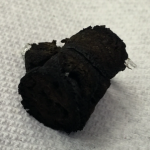
understand the property and possible applicability of the developed sponge materials. Next week I will also synthesize samples for proper environmental applications such as oil and dye absorption.
Week 05: Research in the U.S. vs. Research in Japan
I am enjoying myself through research at Rice University and daily life in Houston. One reason is that I am able to learn a totally new science field, materials science. I have never studied it in Japan and learning about it in the field helps me expand my knowledge apart from my original major, water treatment. Another one is that I can always feel the internationalism and a national diversity through living in the U.S. so that many people from different countries get together and do their research. While I sometimes have to be concerned about a personal relationship among students when I live in Japan because Japan has a closely related society, I do not need to care about such things in the U.S.; since we can directly be involved and communication about doing our research and project. On the other hand, compared to the orientation programs in Tokyo and Rice University, I felt that Japan has a good environment for research as well as the U.S. I listened to many lectures before coming, which told me how great impact the research abroad has to my career. As I described in my weekly report when I interviewed Prof. Vajtai, Japan has the latest equipment and also precedes other countries in the cutting edge research in various fields, some of which may be more advanced than those in the U.S. To be honest, I felt sometimes embarrassed when using experimental equipment in the lab. For example, when I used a balance in the laboratory, the weight was fluctuated a lot and it always took a longer time to weigh than in Japan. Since it is essential to weigh samples correctly in material science, I am curious about how reliable the scale is and wondering whether I can take an exact weight of the samples. I think that cultivating international technical skills in research and also publishing the results in new fields are highly valued in the U.S., while the quality of some experiments is more valued in Japan. Although I know only a few Japanese colleges and Rice University in the U.S. with regard to research, I am aware that Japanese equipment is more accurate and precise. I believe Japanese companies provide high quality equipment for measurement to us, including Nakatani Company, which must be useful when doing successful experiments.
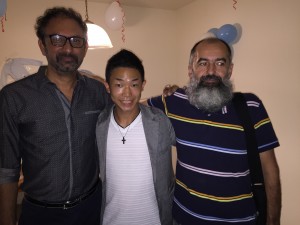
Had a very good time, eating spicy Indian food at his house. Had a photo taken with Professor Ajayan and Professor Vajtai (Ajayan’s group). ~ Toshihiro Takada
I found that Ajayan’s lab has some rules, some of which are different from those of my college in Japan. Basically we have to wear gloves during experiments so as not to contaminate samples. Another one is we should wear lab coats so that researchers can look cool as well as can be safe and protected. As this is also common in Japan, people share equipment and instruments within the lab. During my research experience at Rice, I have never seen anybody who disagreed or had different opinions to others. However, I had different opinions to my mentor regarding the state of progress of my project. Unfortunately, it made him feel unpleasant. Through the discussion with him, I strongly felt that I had to acquire proficient and accurate English to make myself understood correctly. Since Ajayan’s laboratory has many international students, I sometimes hear other languages than English. Actually my mentor, who is from India, likes learning different languages and I sometimes taught him Japanese. I was also able to learn Hindi and other languages from him and other members of Ajayan’s. To my surprise, he often gave a greeting to me in Japanese, which made me happy. Generally speaking, I spent most of time speaking Japanese doing my research in Japan, so this experience brought me a new aspect to cultural engagement. Actually, I was invited to my mentor’s house this week when he planed to hold a baby shower for him and his wife. I talked to many people including Professor Ajayan and Professor Vajtai and ate traditional Indian food there. Although the party was held off campus, I found that students equally communicated with each other people. Personally, living in the U.S. is much more comfortable to me than in Japan.
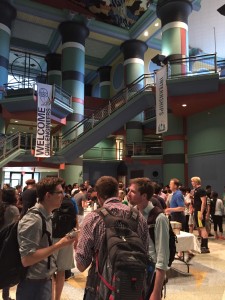
Talked with students who are studying engineering, eating lots of ice creams. ~ Toshihiro Takada
Question of the Week
Is it common for universities in the U.S. to hold events serving food for free such as meal and ice cream? In fact, I joined many food events since I came to Rice, one of which was the “Ice Cream social” held this week. I was able to eat ice creams for free and talked with people who were studying in engineering fields, which was a good experience for me. I had hardly joined free meal events held by universities in Japan, so I was glad to join the event and eat a lot of food for free.
- Yes, there is often free food at campus events in the U.S. since the belief is that students won’t come if free food is not provided. So it is way to encourage students to take a break from their studies or research and come out and enjoy spending time talking casually with others in their department or other studies from different departments on campus. Some students turn it into a game, seeing just how many free ‘meals’ they can get in a week by attending various campus events.
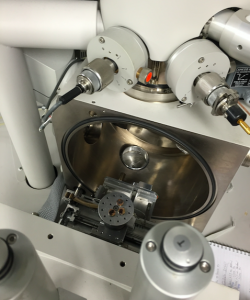
Put the samples into the instrument to analyze the scanning image. ~ Toshihiro Takada
Research Project Update
This week, I tried to characterize the sponge materials made last week, which had various ratios among GOs solution, TEA, and CuSO4. In order to analyze them, I used XRD, DMA, and SEM. XRD is basically used for identifying the atomic and molecular structure of a crystal by X-rays radiation to diffract into many specific directions. Thorough the characterization, I was able to figure out the XRD patterns of my samples, one of which had one peak with an original characteristic trend of the GO. The next analysis was SEM, which is a type of electron microscope that produces images of samples by using electron beams. It showed the surface images of the samples in details. I also asked one of members of Ajayan’s group, a specialist of DMA, to characterize the samples by using DMA. It is used to study and characterize materials, in particular which is useful to know their viscoelasticity. However we had one problem when I analyzed the samples. They did not have enough their mechanical stiffness and strength to be measured by DMA. For this reason, I had to make another sponge material again, changing the proportion of polymer added. Although I did not finish analyzing my samples yet, I will try to characterize them by next Wednesday.
Since I was supposed to submit my poster as a first draft within this week, I also focused on preparing it. Fortunately, I finally decided the title of my poster presentation, which was “Synthesis and Characterization of Metal-Organic Frameworks for Multifunctional Applications.” Although I was able to fill in introduction and methods sections because I already finished them, I had to think more about layout and colors of my poster. Considering other Nakatani U.S. students posters presented last month at Rice University, I also made up my mind to make my poster colorful, concise, and clear as much as possible in order to attract audience. I sent my first draft to Dr. Krupa, who taught Nakatani Japanese students in the special lectures entitled as “Preparing and Presenting a Scientific Research Poster” in August. Next week is the final one for me to do my research, and I have to finish it anyhow. Because I have limited time and due to the submission of my poster, I will just analyze two or three characterization to my samples and put the results into my final poster. Furthermore I will analyze these samples and try them to oil absorption experiments, and finally make a poster presentation on September 16. Although I have to do a lot of things for the coming presentation, I am looking forward to presenting my poster to the audience with those data.
Week 06: Final Week at Rice & Research Poster Presentation
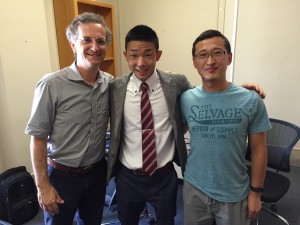
A photo with visiting scholars with whom I exchanged many ideas ~ Toshihiro Takada
My 5-week research internship at Rice University finally ended. Through this invaluable experience, I feel that my mind towards the U.S. and also Japan has changed. One of the feelings was that living in the U.S. was personally so suitable and comfortable that I would like to stay and work here in the future after graduation of my college. The first reason is that I was able to be dedicated to my study with little concerns about personal relationships with others. As written in the previous report, I did not need to care too much about small jobs and the relationships with other people unlike in Japan. I was able to focus on my research and what I wanted to study and learn about. The second one is the research environment. Because there are a lot of people from different countries who have different background and ideas, especially at Rice, it was easier to acquire broad knowledge and skills through living together with them. Although it was sometimes hard for me to make myself understood in English, I believe that I was able to learn many different perspectives on science from them. The last one is about the people living in the U.S. People in Texas are genuinely friendly and talkative, and I was able to talk to people easily and have many conversations. I enjoyed every conversation from small talk to more serious discussion with regard to environmental concerns such as oil and natural gas usage in the U.S. In addition, even though they speak different languages, such as Spanish, I was able to learn a little bit from them and tried to speak in their language.
I have achieved some of the goals I outlined before coming to Rice. I believe that my goals for my future career as a scientist have become more apparent and have expanded. I also learned about differences between the U.S. and Japan in terms of research; they are regarding publications and internationalization. Since the U.S. is one the cutting edge of technology and science in the world, many intelligent people are studying and doing their research here.
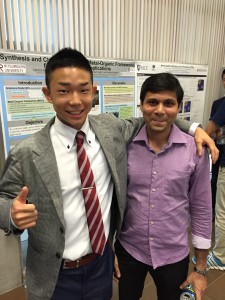
On the last day with my wonderful mentor, Dr. Ashok, at the RCQM colloquium. ~ Toshihiro Takada
Furthermore, people easily look at the papers and articles written in English, so doing research in the U.S. more naturally allows us to become well-known in our field. I also tried to explain as much as I could what I was studying in science and my specialization, so I feel my technical English skills are much improved than they were before. On the other hand, I had other goals, which were not achieved. The purpose of my research at Rice was the synthesis of Metal Organic Frameworks using Graphene Oxide in material science, which was quite different from my initial interest, water treatment. For this reason, I could not learn how the water treatment system in the U.S. was and see the small modular units to provide water in the Nanotechnology Enabled Water Treatment (NEWT), either. I felt a little disappointed, however, I was able to learn a new science field in terms of material science through this program. I would not have found this hot topic with regard to nano-science if I had not come to Rice.
Before I came to Rice, I was thinking about my future career and whether I should go to graduate school abroad or not. I did not know very well what research in the U.S. was like and I could not do anything but check the websites in each university and listen to those who did research in the U.S. before. However, I was able to experience U.S. research first-hand through this research internship at Rice. As the saying goes, seeing is believing, and my motivation to study and do research in the U.S. is now higher. To be honest, I am now planning to apply for graduate school in the U.S. and I will prepare for it as quickly as possible after going back to Japan. I hope to come back to the U.S. again as a graduate student, and I also would like to work here as an engineer. Living in Houston, Texas, I hardly had any frustrations in the daily life because I truly enjoyed it. I was able to go to many places where I experienced U.S. cultures and also enjoyed U.S. food such as hamburgers and a big steak. However, I sometimes got frustrated because of my lack of English communication skills. When I talked about specific topics, I sometimes could not make myself understood and clearly deliver what I wanted to say. Also, as I wrote written in the previous report, I still have to acquire the proficient English skills so as not to make myself misunderstood.

Enjoyed myself to introduce my research during this program at the RCQM colloquium. ~ Toshihiro Takada
Final Research Project Update
Research Host Lab: Ajayan Lab, Materials Science & Nanoengineering, Rice University
![]() Research Project Poster: “Synthesis and Characterization of Metal-Organic Frameworks for Multifunctional Applications”
Research Project Poster: “Synthesis and Characterization of Metal-Organic Frameworks for Multifunctional Applications”
This week was the final one for me to finish my research project. I made one more gel material for my project. I finally got some data when I analyzed my samples by SEM and XRD last week, so I put them into my poster. Considering the results of my research, I finished up my poster quickly because the submission deadline was approaching. I barely made it on the submission day. On the final research day, my mentor invited me a final coffee break in the afternoon, which was unusual for me. Since I spent a lot of time with him during the research, I felt very sad and that I would miss him when I to leave Rice. I learned many important things about liveing and do research in the U.S. from him. I made a poster presentation on the final day at the RCQM colloquium, Rice University. Although it was my first time to present my poster about research, I enjoyed myself. I prepared what I was going to say and explained to the people to some extent. However, when I presented my poster, the audience asked me a lot of questions in each section, and I felt I should have searched more in details in the field. I hope to make improvements for next time when I make a poster presentation by getting sufficient knowledge and backgrounds. I will definitely miss the people I met here. In order to understand the culture and personality in the U.S., I tried to talk to as many people as possible. I was able to share Japanese culture and attractions with them and get the new cultural engagement from them. I will never forget these memories of each person I met. Although I was supposed to finish my project before I leave, it was still not finished. It still has to be continued characterization for samples in order to know their properties. For this reason, I will keep in touch with my mentor until the research is published.
Question of the Week
One question I have is about the system of visiting scholars at Rice University. Because I had hardly met scholars to research in Japan and Ajayan’s research group I joined has many scholars, I wondered how they worked together and collaborate with the research group.
- Oftentimes, the visiting students and scholars in the group are from the labs of the professor’s collaborators abroad. So if, for example, Prof. Ajayan as an active research collaboration with a professor at a university in the United Kingdom and that profess has money to send one of their students to the U.S. to work on a short-term experience he may ask Prof. Ajayan if he can host the visiting student. Or, sometimes, Prof. Ajayan may meet students or researchers at conferences suggest they come to Rice to work in his lab for a time. Other times, students do research online and look for professors in their field of expertise. Then, they send a ‘cold’ or ‘blind’ email to Prof. Ajayan with their resume and asking him if there are any positions open for them to come do research in his lab. Typically, visiting students are not paid for by the professor or Rice University but must have their own funding either through their home university abroad, a fellowship or grant, or must pay for their own costs individually.
Week 07: Visit to Washington, DC & New York City
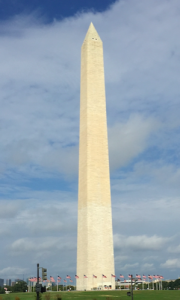
Felt great dignity and as if the time would be stopped. ~ Toshihiro Takada
The Nakatani Japanese students left Houston, Texas on Saturday and arrived at Washington, DC, the capital city of the U.S. Since this was my first time to go to the east coast, I was looking forward to seeing and experiencing different cultures and atmosphere compared to the Southern area. During our stay, I had many impactful activities, one of which was visiting White House and talking to Mr. Kei Koizumi, who is an assistant director of Federal Research and Development at the Office of Science & Technology Policy. Through his conversation, I was able to learn how the government officers work under the President, how they develop and build the research fields in the U.S., and also how they contribute to the environmental sustainability regarding emissions of greenhouse gases based on the Paris agreement adapted last December. After our stay in Washington, DC, we went to Manhattan in New York City and visited the headquarters of the United Nations (UN). We had a special talk there with Mr. Alex Roehrl, an Economic Affairs Officer of the UN Department for Economic and Social Affairs, and Mr. George Hays, a representative of the UN and the World Corrosion Organization (WCO). I was able to learn more about current international issues and ideas the UN has. Since both speakers have been working for the UN, the most important organization for international relations in the world, and their talks included sustainable development and water problems, both of which were related to my study, I was very fascinated by their statements. I believe there are difficulties in future prospects for sustainable development because it is hard to catch up with our changing technologies and keep adapting to more advanced technology.
I was surprised at the highly competitive society of the U.S. in order to get grants and fellowships for science & technology. Listening to many lectures and topics about research funds, I thought that those who are involved in research fields in the U.S. try desperately to get enough money to conduct their research (and fund their PhD students), which may cause their motivation to be much higher and behavior more aggressive than Japanese researchers. However, I found Japan also has similar grants to support and foster young and distinguished researchers when visiting Japan Society for the Promotion of Science (JSPS) in Washington, DC. The JSPS has mainly three types of grants to support those who study science and technology, which are for researchers (KAKENHI), fellowships (from post-docs to professors), and international collaborations (Bi- and multi- lateral). While staying on the east coast this week, we had a great opportunity to visit some universities in order to understand the research environment of the U.S, one of which was Howard University in Washington DC. We had lectures about its history and research fields by Dr. Thomas Searles, who graduated from Rice University as Ph.D. He kindly guided us around the campus and showed their new laboratories, which will be opened this November. We also visited Columbia University in New York City. Professor Yasutomo Uemura in the Department of Physics, whose research topic is Condensed Matter Physics, hosted and arranged us a campus tour and lab visit for each student. I was able to meet some professors who specialize in wastewater treatment and see what they focus on in their water studies by visiting their laboratories.
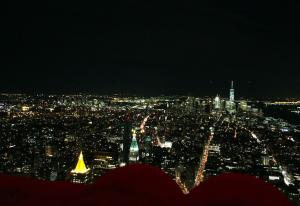
A lot of lights in the city change the New York City incredibly beautiful, which made people feel happy. ~ Toshihiro Takada
Despite the short stay in both cities, I was able to do some activities and enjoy sightseeing that I only could experience there. I went to some museums in Washington, DC, such as the Museum of Natural History and the National Portrait Gallery & Museum of American Art, which were good for knowing and recognizing the history of the U.S. as well as comparing to the museums I visited in Houston. Since the U.S. government financially backs most museums in the D.C., it is free to enter them. Japan has fewer museums with free entrance compared to the U.S., so I thought that visitors from other countries might increase if more traditional Japanese facilities with free entrance are introduced, especially in Tokyo where many foreign people visit. I also visited some historical monuments in both cities and learned how the U.S. had built its current status in exchange for the sacrifices of many. I felt this kind of feelings in Hiroshima in Japan too, which suffered from atomic bombing and now developed a peaceful park honor the memory of those who died as well. I had a strange feeling but it also felt comfortable to be there. In New York City, I went to some of the most popular sightseeing spots in the world such as Times Square, famous for many theaters in the Broadway, and the Empire State Building. A hundred thousand of lights make the city bright, and I was very impressed by the night view from the roof top terrace.
We finally came back to Japan, arriving at the Narita Airport. To be honest, I was relieved to see familiar sights in Japan. Since I have heard English this whole summer, hearing Japanese was unfamiliar to me. However, when I ate Japanese food such as
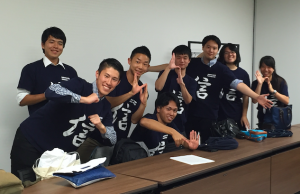
Last group photo with Nakatani Japanese students. ~ Toshihiro Takada
rice balls at convenience stores after a long time, I felt they were familiar tastes to me. On the final day of this program, I had a closing ceremony at the Sysmex Corporation in Tokyo. Each Nakatani Japanese Fellow made a presentation with regard to cultural difference between the U.S. and Japan experienced through this program and the research they conducted at Rice. We also had a great opportunity to talk with Professor Shigeo Maruyama from the University of Tokyo whose main research is Nano-materials such as carbon nanotubes and graphene at the University of Tokyo. He did research at Rice University for two years under Prof. Richard Smalley, who got the Nobel Prize in Chemistry for the discovery of a new form of a carbon, fullerenes. He told us how studying and researching at Rice with him impacted his career path and later life. Through this talk with him, I understood that we had to compete with others involved in the same field of science from all over the world.
Question of the Week?:
The final question I have is about protest activities in the U.S. When I was walking on the way to the Empire State Building in the NYC, I came across many people who were protesting against having guns and racial discrimination. I have often seen such activities in Kyoto and Osaka, some major cities in Japan, but are they provoked in the U.S. too? What kind of issues is the most debatable and controversial among American citizens?
- Yes, in this U.S. this is called the ‘Right to peaceful assembly’ and it is actually enshrined in our constitution under Amendment I which states: “Amendment I. Congress shall make no law respecting an establishment of religion, or prohibiting the free exercise thereof; or abridging the freedom of speech, or of the press; or the right of the people peaceably to assemble, and to petition the government for a redress of grievances.” People protest against many things but the most common are war/military action, environmental issues, racial disparities and equality issues, abortion rights, and sometimes protests against global trade or economic policies. Non-violent protests were very powerful during the Civil Rights Movement in the 1950s and 1960s when they led to desegregation of schools, buses, and, eventually all public spaces in throughout the south. This is where Martin Luther King’s famous “I Have a Dream” speech that he gave in front of the Lincoln Monument in Washington, DC comes from. However, you cannot protest on private property and often to hold a protest or large gathering in a public space you need to request a permit from the city or local government. This way they can station police officers nearby or along the route of the protest (if it is a march) to ensure the safety of the protestors and others. This is why you saw all the police in New York City blocking off the streets and traffics so that the protestors that were marching by could safely cross the street.
Final Report: Reflections on the Nakatani RIES Fellowship
Now that I returned home and I have kept busy studying for my undergraduate dissertation at my college, I want to explain to my friends and others who I have been involved in how I felt about the experience and important things I obtained from the Nakatani RIES Fellowship program. When I talk to my family members about the program, I am willing to tell them about U.S. culture because they might not know my research topic well. However, my parents lived in the U.S. before and should want to know about my life and feelings here, so I would mention that I was able to experience many cultural differences between the U.S. and Japan, some of which made me feel both pleased and surprised. I want to emphasize that the U.S. has many more free amusements and exhibitions that allow us to gain knowledge and cultivate creativity. I also may refer to people’s consciousness and thinking of environmental concerns and sustainable development because they are important for all people in the world to share these kinds of attitude. My parents will be happy if I tell them that I watched exciting American sports such as football and baseball for the first time.
I would say to my professor that doing research in the U.S. has some advantages and different characteristics compared to those of Japan; the educational systems such as enabling students to experience research and join projects since the early stage of undergraduate students, sufficient financial support for Ph.D. students, and publishing their articles. However, I would not forget to mention that Japan has many advantages as well as the U.S. too; many high quality instruments which are essential to have good results in research, accuracy and credibility of experiments and results, and unity of each laboratory group. Although he has been to the U.S. many times, and may already know about its research style, I would highlight that each research field has its own features and merit, some of which are based on their life style and tradition. I also would tell him that the research group that I belonged to had many Ph.D. and Post-doctoral students, which made me cultivate not only my research skills but also international visions and ideas. My college does not have such a large laboratory that I should be the only one who gained research experience in a completely different situation.
When I meet students at my university, I would tell them that how important it is to join a research internship abroad, and in particular I want to recommend it to those who want to become a scientist in the future. Few undergraduate students have joined such a research experience and get learn what research is like in the U.S., so I strongly recommend Japanese students in science fields to participate in this Nakatani RIES program. I also would emphasize the advantage of making connections with other university students in Japan like those who I met in the program. Students living in a local area hardly have any chance to meet other Japanese students in different areas, especially to meet those who are studying in science in Kansai or Kanto regions. Although I was the only student who joined this program from the Kansai area, I had a great respect for other students because they had a strong motivation to study and do research abroad. In this program, I was able to gain many different perspectives, thinking, and knowledge from the other seven Nakatani Japanese fellows as well as formed good relationships with them. Those who want to participate in the program should have similar goals with each other in regard to science, and the friendships will last a long time. I would recommend that students who wish to participate try to make strong connection with other participants.
This program gave me a great opportunity to experience research and aroused in me an enthusiasm for studying and doing research abroad. Though I may change my mind for my future career goals, this program at least made them clearer than before. For these reasons, first, I will apply for a graduate school in foreign countries in order to acquire a master’s degree and make one of my future goals explicit about working abroad. I had this idea before going to the U.S., but thanks to the program, my motivation is now much stronger. I am now preparing applications for entrance to graduate school abroad. I hope to get acceptance to study from some of them next year after my graduation from college. Second, since I have had many opportunities to meet those who were working actively in both science and political fields, my ideas for job fields were also expanded. I hope to become an engineer, who is working for a water company using a specific technology, yet I recognize that there may be another career path such as working on the government on science policy.
The most important thing I have for advice to future participants in the Nakatani RIES Fellowship is to make your goals clearly before applying for the program. Setting a precise and concise aim as a scientist should be useful. I would have some simple questions for you and ask like this. “Do you want to get a Master or Ph.D. degree in the U.S.? What is your future goal as a scientist? Do you want to become a professor and do your research in academia in the future?” These questions are very simple, however, you may not be able to answer all of them instantly. Future prospects such as being a scientist and being able to make your dreams come true is one of important advantages in this program. I am sure that you will have a precious experience if you already have clear future goals. I hope that many people who are majoring in science in Japan will apply for the program and obtain the wonderful opportunity!
